Cells on Duty in the System
If an enemy overcomes all barriers and succeeds in entering our body, this does not mean that the defence army has been defeated. On the contrary, the real war has just begun, and the main soldiers come into play at this stage. The first soldiers to meet the foe are the eater cells, that is, phagocytes, which continuously travel in our body and keep control of what is going on.
These are "special cleaning cells", which ingest the unwanted microbes that have penetrated the inner surfaces of the body, and alert the defence system when necessary.
Certain cells in the defence system capture, break down, digest, and eliminate the miniscule particles and liquid foreign matter that have entered our body. This event is called "phagocytosis". (cell engulfing)
Phagocytosis is one of the most important elements of the immune system. It provides an immediate and effective protection against infections.
Phagocytes, considered the "police forces of the body," can be examined under two separate headings.
1. Mobile police forces: These roam in the blood and shuttle forwards and backwards between the tissues when required. These cell units, which circulate throughout the body, also serve as scavengers.
2. Immobile police forces: These are immobile macrophages, which are situated in the gaps in various tissues. They perform phagocytosis on the micro-organisms from where they are, without moving.
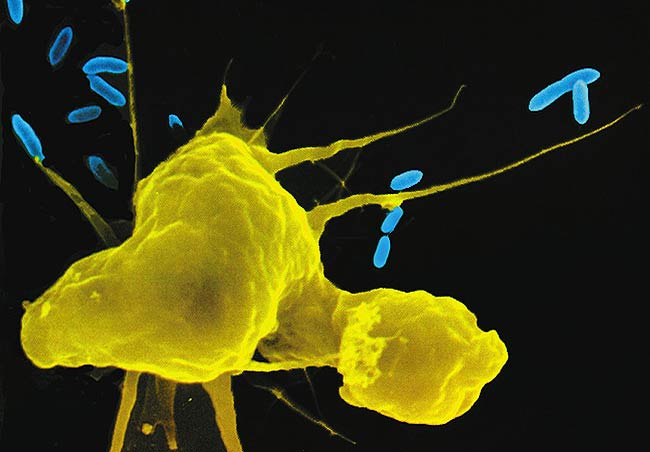 |
| Phagocytosis in progress. The macrophage (yellow) while digesting the bacteria (blue). |
If the invader antigens (foreign micro-organisms) are few enough for the present eater cells to deal with, they are destroyed with no extra alarm being given. But if the invader microbes are too great in number, the eater cells may fail to get them under control. Unable to digest all of them, they expand in size. When distended by the antigens, the cells burst, causing a liquid substance (pus) to overflow. This does not mean that the war is lost. So far, the eater cells have just met the microbes, which have still many tougher barriers to pass. The formation of pus activates the lymphocytes, which have been delivered from the bone marrow, the lymph nodes, and above all, the thymus. In a second wave of defence, the newly arriving defence cells attack everything they find around, including cell debris, available antigens, and even old white blood cells. These defence cells are the real eater cells, — the macrophages, a type of phagocyte.
The First Aid Forces: The Macrophages
When the war becomes intense, the macrophages swing into action. Macrophages operate in a specific manner exclusive to themselves. They do not become involved in a one-to-one combat like the antibodies. Unlike the antibodies, they do not work with a system similar to a bomb aimed at a single target. Just like a gun firing lead shot, or a bomb that can be aimed at many targets together, the macrophages can destroy a great number of enemies together, all at the same time.
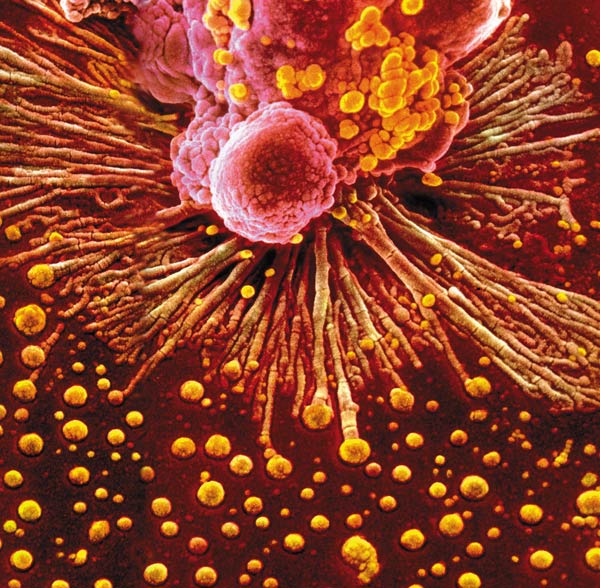 |
| To the top, you can see macrophages while trying to ingest foreign materials. |
Like all other defence cells, the macrophages are also derived from the bone marrow. The macrophages, which have a very long life span, can live for months, and even years. Despite their small size (10-15 micrometers), they are highly crucial for human life. They possess the ability to absorb and digest big molecules in the cell through phagocytosis (ingestion).
Their characteristic of ingestion makes them the scavengers of the defence system. They remove all materials that need to be cleaned up, such as micro-organisms, antigen-antibody complexes, and other substances similar in structure to an antigen. At the end of these processes, substances that would be qualified as antigens are digested, and thus pose no further threat to the organism.
General Alarm
When a country is involved in war, a general mobilization is declared. Most of the natural resources and the budget are expended on military requirements. The economy is re-arranged to meet the needs of this extraordinary situation and the country is involved in an all-out war effort. Similarly, the defence system would also announce mass mobilization, recruiting all of its elements to fight the enemy. Do you wonder how this happens?
If enemy members are more than the currently fighting macrophages can handle, a special substance is secreted. The name of this substance is "pyrogen" and it is a kind of alarm call.
After traveling a long way, "pyrogen" reaches the brain where it stimulates the fever-increasing centre of the brain. Once alerted, the brain sets off alarms in the body and the person develops a high fever. The patient with a high fever naturally feels the need to rest. Thus, the energy needed by the defence army is not spent elsewhere. The pyrogen produced by the macrophages is perfectly designed to trigger the fever-raising mechanism of the brain. Therefore, the macrophage, and the pyrogen, and the temperature-raising centre of the brain, and the brain have all to be created at the same time.
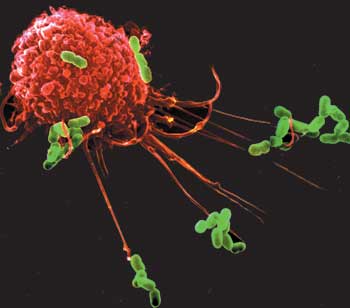 | 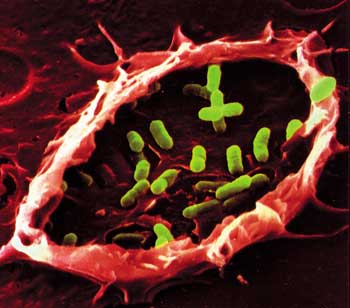 |  |
| The macrophage while ingesting the bacteria step by step. The macrophage extends forward to capture the bacteria. | The bacteria are captured and trapped within the extensions of the macrophage membrane. | The bacteria, which are trapped in the macrophage membrane, are absorbed one by one. |
As is evident, there is a perfect plan at work. Every requirement is created flawlessly for this plan to succeed; the macrophages, the pyrogen substance and other similar substances, the fever-raising centre of the brain and the fever-raising mechanisms of the body…
In the absence of even one of these, the system would simply not work. Therefore, it can by no means be claimed that such a system could have originated step by step through evolution.
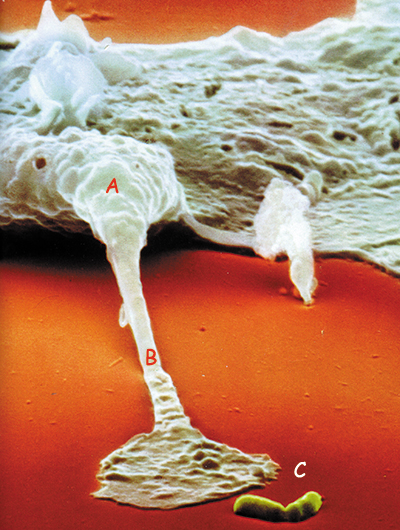 |
| The macrophage (A) trying to reach out to the bacteria (C) and entrap it with an extension called pseudopodia (B). |
Who, then, has made this plan?
Who knows that the body’s fever must rise, and that only that way the energy needed by the defence army will not be spent elsewhere?
Is it the macrophages?
Macrophages are merely tiny cells invisible to the naked eye. They do not have the capacity to think. They are living organisms that only obey an established superior order; they merely carry out their duties.
Is it the brain?
Definitely no. Nor does the brain possess any power to create or produce something. Just as in all other systems, in this system, too, it is in a position not to give orders, but to obey orders and submit to them.
Is it man?
Certainly not. This system protects man from certain death, although he is not even aware that such a perfect system is at work in his own body. Even if man were ever ordered to develop an army in his own body to fight the enemy and cause his fever to rise, and provide this army to work round the clock in his entire body, he would simply have no idea what to do.
Today, mankind is not even able to understand the details of the present order in the defence system, despite all the technology at its disposal — much less imitate it.
It is an obvious fac that man was created with all of his features in place. Willingly or unwillingly, he submits to his Creator and the systems He established. Just as everything else does…
…No, everything in the heavens and earth belongs to Him. Everything is obedient to Him. (Surat al-Baqara: 116)
Information Transfer
Another incredible function of the macrophages is supplying the lymphocytes, i.e., the B and T cells, which are the real heroes of the defence system, with information about the enemy. After phagocytosing the antigen, the antigen-presenting cells go to the lymph nodes (lymphatic tissue) through the lymphatic channels.
This is a very important detail. Only if a cell possesses consciousness and reason can it be capable of supplying and forwarding the information pertaining to an enemy to the relevant centres. For the macrophage cell to know that this information will be processed by the lymphocytes, it has to be perfectly informed about the general strategy of the defence system. It is very clear that the macrophage, just like all the other cells, is the obedient element of a totally integrated system.
Top Heroes: The Lymphocytes
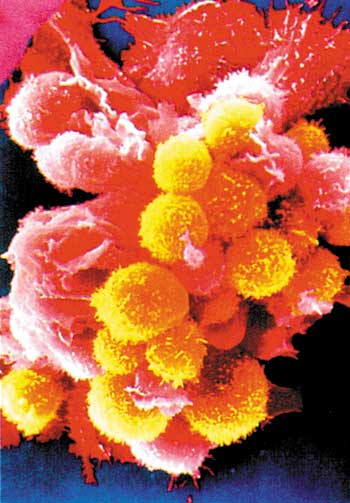 |
| Lymphocytes at war (yellow), fighting with cancer cells. |
The lymphocytes are the main cells of the defence system. The intense war in the body can only be won with the strenuous efforts of the lymphocytes. The life stories of these cells are full of incredibly interesting and wonderful stages, each of which, standing alone, is enough to demonstrate the decrepit nature of the theory of evolution.
These bold warriors are present in the bone marrow, lymph nodes, salivary glands, spleen, tonsils and joints. The lymphocytes are primarily present and produced in the bone marrow.
The formation of lymphocyte in the bone marrow is one of the most mysterious events of biology. Here, stem cells rapidly pass through a number of biological stages and take on a completely new structure by turning into lymphocytes. (A stem cell is an unspecialized cell that gives rise to a specific specialized cell, such as a blood cell.) When it is considered that, despite the great developments in genetic engineering, the transformation of even the plainest microbe species into other similar species is considered impossible, the mystery of this event, which takes place in the bone marrow, becomes even greater. This mystery, unsolved by science to date, is a very simple process for our body. For this reason, many evolutionist scientists have confessed that natural selection or mutation tales cannot account for the mystery in such a transformation. Prof. Dr. Ali Demirsoy stated that a complex cell like the lymphocyte, which carries almost all the responsibility of the war, could not have evolved from a simple cell:
Complex cells have never been generated from primitive cells through an evolutionary process as recently suggested. 7
This fact is actually very well known by the scientists of our day. Yet, obviously, when they accept this fact, they will equally be obliged to accept the existence of a Creator. This is something which most of them are very reluctant to do.
The world renowned biochemist Michael J. Behe states that evolutionists disregard some facts for the sake of denying the being of Allah:
Also, and unfortunately, too often criticisms have been dismissed by the scientific community for fear of giving ammunition to creationists. It is ironic that in the name of protecting science, trenchant scientific criticism of natural selection has been brushed aside. 8
Lymphocytes, the products of this mysterious transformation, which is one of the facts ignored, play a very interesting role in the defence system. They check on the body cells several times a day to see if there are any sick cells. If they find any sick or old cells, they destroy them. There are almost 100 trillion cells in our body and lymphocytes make up only 1%.
Now, imagine a country having an exceedingly high population, around 100 trillion. The number of health care workers (lymphocytes) would then be 1 trillion. If we think that the world’s current population is some 7 billion, the number of the people living in our imaginary country would be almost 14 million 285 thousand times the world’s population. Would it be possible for all the members of a country with such a high population to have a check-up one by one, and moreover, several times in the same day?
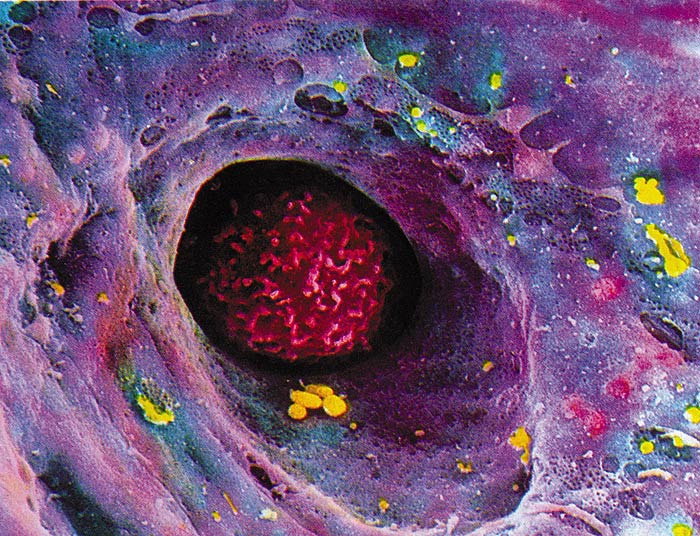 |
| Devriye gezen bir savunma hücresi: lenfosit |
You will surely say no, but this process is carried out in your body every day; lymphocytes roam throughout your body several times a day to do a health check.
Is it possible to attribute the extremely organized operation of such a great mass of living beings to coincidence?
Can coincidences account for each one of a trillion lymphocytes assuming such an arduous and demanding task?
Certainly not!
Allah, the Lord of all Worlds, created each one of these one trillion lymphocytes and charged them with the responsibility of protecting man.
Lymphocytes play a very important role against major infectious diseases such as AIDS, cancer, rabies and tuberculosis, and serious ailments such as angina and rheumatism. Of course, this does not mean that lymphocytes do not have any role to play with other diseases. Even the common cold is nothing but a combat fought by the lymphocytes to keep those very dangerous common cold viruses away from the body.
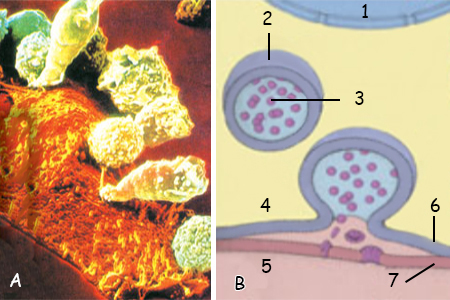 | |
| 1. T-cell nucleus | 5. Interior of targeted cell |
| In immune individuals, killer T cells attack and destroy cells bearing a foreign antigen, such as virus-infected or cancerous cells. These T cells have storage vacuoles that contain a chemical called perforin because it perforates cell membranes. During the killing process, the vacuoles in a T cell fuse with the cell membrane and release units of the protein perforin. These units combine to form pores in the target membrane. Thereafter, fluid and salts enter so that the target cell eventually bursts. | |
The human body can defeat many of its enemies by using antibodies. This may lead you to wonder why lymphocytes intervene in the war directly when they already make a considerable contribution by producing antibodies. However, some microbes are so deadly that very strong chemical toxins are needed for their removal. Therefore, some lymphocytes use these chemical toxins and directly participate in the war.
How then would the defence system stop these enemies?
First, chemists and a laboratory would be needed to produce the toxin. The structure of the required material is too special to be formed by coincidence. Allah, Who knows that the human body will face such an enemy, or rather, Who created such an enemy for man to take warning, has also given the lymphocytes to synthesize this toxin.
So, is this chemical material satisfactory?
No, because this substance cannot freely circulate in the blood, as this would mean the death of our own cells as well.
How then will this toxin be used without causing any harm to our cells?
The answer to this question is hidden in the perfection of the creation of the lymphocytes. Toxins are placed in sacs located in the cell membrane of the lymphocytes. This helps the chemical weapon to be used easily. The lymphocyte injects this toxin only when it contacts the enemy cell, eventually killing it.
The lymphocytes come in two types: B cells and T cells.
The Weapon Factories of the Human Body:
The B Cells
Some of the lymphocytes produced in the bone marrow depart when they mature and become fully functional, and are transported to the lymphatic tissues through the blood. These lymphocytes are called the B cells.
B cells are the weapon factories of the body and they produce the proteins, called antibodies, which are meant to attack the enemy.
The B Cell Pathway
 |
| A B cell during division |
The cells undergo a highly complex and laborious process to become B cells. These cells must first pass a severe test in order to become the warriors who will protect human health.
In their initial phase, the B cells rearrange the gene fragments that will form an antibody molecule. These genes are actively transcribed as soon as the rearrangement is complete. At this point, it is very important to note how a tiny cell can perform complex tasks such as arranging and transcription. What is arranged and transcribed is actually information. And information can be arranged and organized only by a being who possesses intelligence. Furthermore, the outcome after the arrangement is extremely important: this information will later be used in the manufacture of antibodies.
The transformation of B cells rapidly goes on. Upon an order coming from an unknown source, cells produce proteins called "alfa" and "beta", which surround the cell membrane. At a further level, a range of complicated processes are due to take place in the cell to enable it to produce some molecules that will enable it to bind to antigens. At the end of all these complicated operations, the cells turn into a factory that recognizes the enemy as soon as it makes contact with it, and is able produce millions of different weapons.
Can Every B Cell That Has Been Manufactured Stay Alive?
The more we delve into the details of the defence system, the more miracles we encounter. As stated before, B cells manufacture antibodies. Antibodies are weapons that are manufactured purely to cause harm to enemy cells. So, what happens if the weapons produced by the B cell confuse their targets and start to hit friendly cells?
In that case, the other cells send a signal inside the B cell. This signal is actually an order for the cell to "commit suicide". Eventually, some enzymes in the nucleus of the cell are activated and they decompose the DNA of the cell. A perfectly working auto-control mechanism protects the body, and finally, only the B cells that produce antibodies that cause harm to the enemy can stay alive.
Only comprised of a compact nucleus and very little cytoplasm initially, the B cells undergo unbelievable changes when they meet an antigen. They divide repeatedly and build up thousands of assembly points in their cytoplasm for the manufacture of antibodies, as well as an extensive channeling system for the packaging and exporting the antibodies. One B cell can pump out more than 10 million antibody molecules an hour.
Here is a single cell that transforms itself into a factory competent enough to produce 10 million weapons an hour on meeting an enemy. If we remember that this cell can produce different weapons for each of its millions of enemies, we can better understand the scope of the miracle in question here.
Some B cells become "memory cells". These cells do not immediately participate in the body’s defence, but keep molecular records of past invaders in order to accelerate a potential war in the future. Their memory is very strong. When the body meets the same enemy again, this time it is rapidly geared to the appropriate weaponry production. Thus, defence becomes faster and more efficient.
Here, we cannot help asking ourselves: "How can man, who considers himself the most advanced being, have a memory weaker than that of a tiny cell?"
Unable to explain even how the memory of a normal human being forms and works, evolutionists never attempt to explain the existence of such a memory as a matter of evolution.
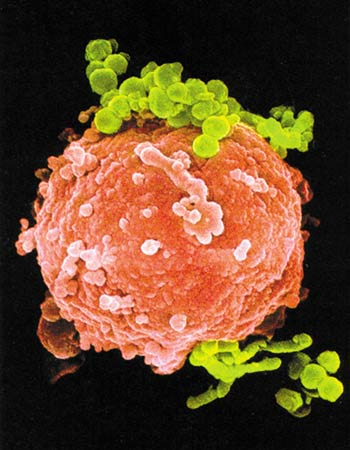 |
| A B cell covered with bacteria. |
If a lump of flesh the size of a hundredth of a millimeter had only one single piece of information, and used this information for the benefit of mankind in the most accurate way, even this would be a miracle in its own right. However, what we are referring to here goes far beyond that. The cell stores millions of pieces of information for the benefit of man and uses this information accurately in combinations beyond man’s comprehension. Man is able to survive thanks to the wisdom these cells display.
Memory cells are cells specially created to protect man’s health. Allah equipped them with strong memorizing ability by design. Otherwise, it would be impossible for the cell to develop a strategy on its own accord and give itself within this strategy the responsibility for storing information. Moreover, the cell is even unaware of such a need; much less does it feel the need to employ such a strategy.
In addition, there is another important question that needs to be answered about the strong memories of the memory cells. In a normal human being, eight million cells die every second to be replaced by new ones. Therefore, the metabolism continuously renews itself. Yet the life span of memory cells is much longer than the life span of other cells. This characteristic helps them to protect people from diseases thanks to the information in their memories. These cells, however, are not everlasting. Though a long time later, they eventually die. At this point, we are left with a very surprising situation. Memory cells transfer the information they possess to the next generation before they die. People are indebted to these memory cells for not having to be afflicted all over again by the same in diseases they caught in infancy (measles, mumps, etc.).
How then can this cell know that it has to transfer this information?
This surely cannot be attributed to the cell itself, but to the ability granted to it by its Creator.
How Do the B Cells Recognize the Enemy?
In a complete state of preparedness for war, the B cells then learn to discriminate the enemies from the body cells before defending the body.
They do not need to expend much effort to do this, because these cells and the antibodies they manufacture are able to recognize the enemy directly from their shapes without any assistance. A receptor on their surface meets the antigen for which it was programmed, and binds to several small parts on it. Thus, the antigen is identified as a foreigner. In this way, B cells can easily recognize antigens, such as bacteria.
What is the Function of B Cells?
B cells are like guards who are always on the look-out for microbes. When they encounter an invader, they rapidly divide and start to produce antibodies. These antibodies bind to microbes like B cell receptors. The enemy cells that are marked by the antibodies as foreigners are driven out of the body at the end of the relentless struggle of phagocytes and T cells. By the time the B cells inactivate the enemy with the millions of antibodies they have produced, they have also marked it for killer cells. Here, there is another important point, which is as important as destroying and marking foreign cells. It is about how so many antibodies can be produced by a limited number of genes.
As outlined in detail in the section on "Antibodies", the B cells use the genes in the human body to manufacture antibodies. However, the number of genes in the human body is less than the number of antibodies produced. This situation causes no problem for the cells. Despite all these limitations, they succeed in producing nearly 2 million antibody types an hour. 9 B cells interact in various combinations with available genes to make the above-mentioned production. It is literally impossible for a cell to think up these combinations.
These unconscious cells are given the ability to involve themselves in these combinations by the will of Allah. This is because "...When He decides on something, He just says to it, ‘Be!’ and it is." (Surat al-Baqara:117)
No other force in the heavens and on the earth save Allah is capable of ordering even a single feature of the trillions of cells.
It becomes possible only by the will of Allah that a cell performs such mathematical operations as producing the most appropriate weapon to inactivate every enemy that has invaded the cell.
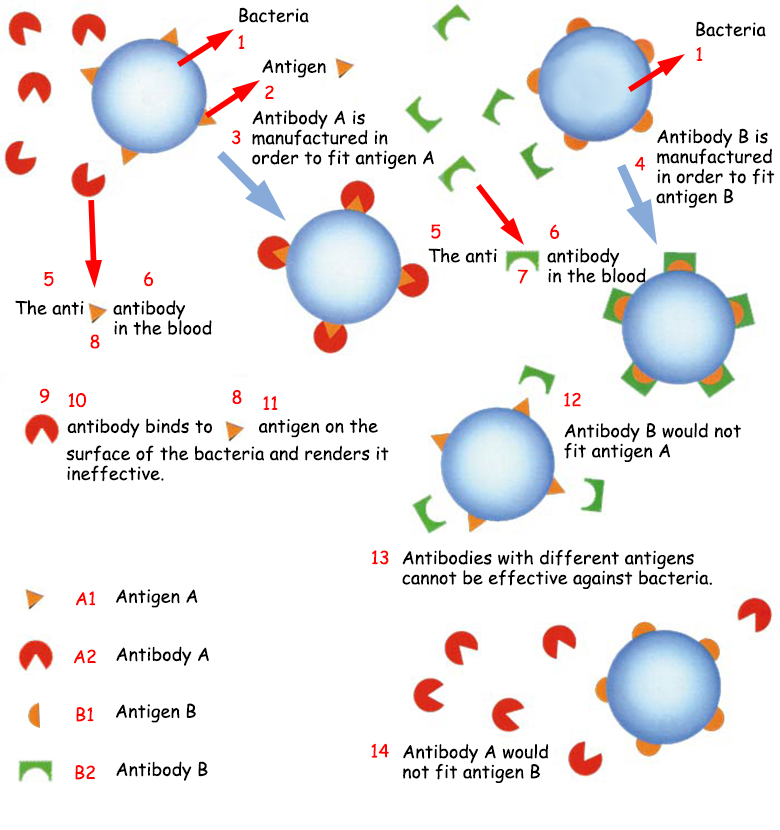 | |
| A1. Antigen A 1. Bacteria | 3. Antibody A is manufactured in order to fit antigen A |
| Bacteria and viruses carry chemicals on their surfaces called antigens. Some lymphocytes produce antibodies to bind themselves to antigens, thus enabling the white cell to easily ingest the bacteria. Antibodies have distinct features and they only bind to antigens for which they are produced. As illustrated in the above picture, a triangular antigen perfectly fits to an antibody, which has a triangular cut. (top left). Yet the same antibody (bottom) does not fit to a round antigen. | |
Brave Warriors: T Cells
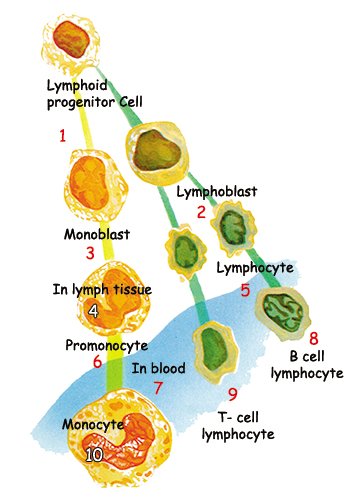 | |
| 1. Lymphoid progenitor cell | 6. Promonocyte |
| The white cells made in the lymph system tissue develop into lymphocytes (B cells and T cells) or monocytes. Lymphocytes are key players in immune responses. Mmonocytes can transform into large phagocytic (engulfing) cells called macrophages. | |
Some lymphocytes migrate to the thymus after they are manufactured in the bone marrow. The lymphocytes, which multiply and mature here, are called T cells. These cells mature to form two different types: killer and helper T cells. After a three-week education, T cells migrate to the spleen, lymph nodes, and intestinal tissues to wait for the time of their mission.
The T Cell Pathway
In comparison to B cells, T cells must go through a much more complicated course to be ready to commence their mission. Just like B cells, they, too, are simple cells in the beginning. These simple cells go through a series of difficult tests to become a T cell.
In the first test, it is checked whether the cell can recognize the enemy or not. The cells recognizes the enemy with the assistance of "MHC"(Major Histocompatibility Complex) located on the surface of the enemy, which is a molecule that subjects the antigen to a series of chemical processes and presents it to the T cells.
Eventually, only those cells that are able to identify the enemy can survive. The others are not tolerated and they are immediately destroyed.
The recognition of enemy cells alone does not ensure the survival of T cells. These cells must also have a very good knowledge of the harmless substances and the regular tissues of the human body so to as prevent unnecessary conflict, which will eventually harm the body.
The T Cell’s Differentiation According to the Order it Receives
The war has not yet ended for the T cells. Some T cells-to-be destroy themselves after receiving a specific signal from other cells.
There is very limited information on the signals that cause the cells to die a programmed death, to continue to live, or to mature and transform themselves. From a scientific point of view, this remains one of the unsolved mysteries of the defence system. Many similar cells in our body receive signals from somewhere, and start functioning upon this signal. How can these cells, which send signals to one another, be aware of the need to send a signal? Mahlon B. Hoagland brings up the same question in his book, The Roots of Life:
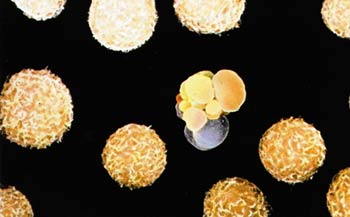 |
| A cell destroying itself (middle). This programmed self-destruction is for the replacement of tissues or the elimination of damaged cells. |
How do the cells know when to stop growing? What tells them that the organs of which they’re a part are not just the right size?… What is the nature of the division stopping signal(s)? We don’t know the answer and we continue to search for it. 10
Indeed, the mystery of the signaling between cells has not been solved yet.
A stem cell would normally be expected to divide to form two new cells bearing the same features.
However, a switch hidden in one of the cells is turned on causing a sudden transformation in the cell. This new cell is the T cell that will fight for the human body. This leads us to ask the following question:
Why does a cell transform itself into a totally different cell?
Science has not answered this question yet. Science can answer the question of how the cell transforms itself, but it can never explain why the cell would want to become a fighter cell.
Nor can it explain who programmed the cell to become a cell that defends the body when the need arises.
Only those who acknowledge the being of Allah can fully comprehend the answers to these questions.
What is the MHC (Major Histocompatibility Complex) Molecule?
MHC is a molecule specially created to help the T cells in recognizing the enemy. They subject the antigen to a series of chemical processes and present it to the T cells. With the aid of MHC molecules, virus particles, cancer cell molecules, and even particles belonging to the inner part of a bacterium can be detected.
There is a very important reason for the T cells to use MHC molecules. This helps them to penetrate host cells and locate camouflaged viruses. However, even the help of the MHC molecule is not sufficient for T cells to fulfill their function. T cells also need a helper cell. Called the APC (antigen-presenting cells) for the sake of brevity, these cells break antigens apart and grab a very important part from the antigen. This part contains the amino acid sequence that determines the antigen’s identity. The T cell is activated when it receives this identity information from the APCs.
As we can see, there is a need for a superb sub-system for the defence system even to start a war. The absence of even a single component of this intelligence network, made up of many interconnected subunits, would render the system useless. Under these circumstances, it would be beyond reason to talk about coincidence in the formation of such an intelligence system. Entertaining such views would be verging on superstition.
There is wisdom at all levels of this system which has been flawlessly created by Allah. An example of this would be the performance of APC cells that bring the enemy to T cells. These cells are aware that T cells can recognize the enemy from its amino acid sequence. This is one of the thousands of pieces of evidence that both cells are created by the same power, that is, Allah.
Either a macrophage or a B cell presents an antigen to a helper T cell. To accomplish this, the antigen has to be digested to peptides that are combined with an MHC protein. The complex is presented to the T cell. In return, the helper T cell produces and secretes lymphokines that stimulate T cells and other immune cells.
Types of T Cells
T cells come in three groups: helper T cells, killer T cells, and suppressor T cells. Every T cell has a special MHC molecule enabling it to recognize the enemy.
Helper T Cells
These cells can be regarded as the administrators of the system. In the initial stages of war, they decipher the properties of the foreigner cells absorbed by the macrophages and other antigen catcher cells. After they receive the due signal, they stimulate killer T and B cells to fight. This stimulation causes B cells to produce weapons called antibodies.
Helper T cells secrete a molecule called lymphokine to stimulate other cells. This molecule somehow turns on a switch in other cells and starts off the war alarm.
The ability of the helper T cell to produce a molecule, which activates another cell, is a very important process.
First, the production of this molecule is related to an impending war strategy. It is obvious that the cells cannot make up this strategy themselves, nor can the strategy come about by sheer coincidence.
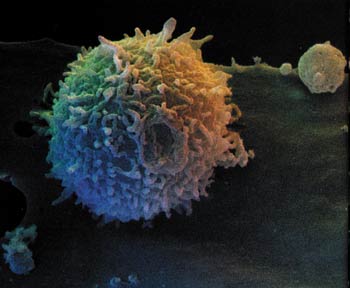 | 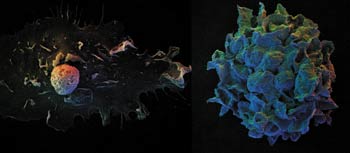 |
| A T cell (left) can get orders to kill from a dendritic cell |
Developing a strategy would not be enough either. The molecule in the cell, which will switch on the production key in the other cell, should be synthesized accurately. For this, it has to be perfectly aware of the chemical structure of the opposite cell.
A mistake made in the production of this molecule alone would paralyze the defence system entirely. This is because an army without communication would be destroyed even before it launched its defence.
The existence of this molecule alone suffices to prove the absurdity of the theory of evolution. This is because the prerequisite of the system is the existence of this molecule right from the outset. If helper T cells failed to alert other cells with the help of this molecule, the human body would surrender to viruses.
How Do Helper-T cells start action? | |
 | |
| 1. Microscopic pieces | 5. Helper-T (CD4) cell |
| The picture illustrates how a cell breaks a microbe apart and presents it to the T cell. As the picture at the right indicates, the T cell will be activated only if its antigen receptor fits to the presented antigen, if the CD4 molecule adheres to the antigen complex, and if some other molecules (right) combine with each other. These safety mechanisms prevent a mature T cell from moounting an immune attack against its host. | |
Killer T Cells
The killer T cells are the most efficient elements of the defence system. In previous chapters, we have studied how viruses are inactivated by proteins called antibodies. There are cases, however, when antibodies cannot reach out to a virus which has invaded a cell. On such occasions, killer T cells kill the sick cell which is invaded by the virus.
A closer examination of how killer T cells kill sick cells would reveal a great wisdom and an artistry in creation.
The killer T cells first have to distinguish between normal cells and those in which invaders hide. They deal with this problem with the help of the innate system (MHC molecules) granted to them. When they locate the invaded cell, they secrete a chemical substance. This secretion sinks into the membrane of the cell forming a hole by lining up sideways in close formation. Following this, leaking starts in the cell which is full of pores, and the cell dies.
Killer T cells store this chemical weapon in granular form. This way, this chemical weapon is always kept ready for use. Scientists were amazed to discover the fact that the cell produces its own weapon by itself and stores it for future use. Even more amazing are the details in the mind-boggling way the cell uses this chemical weapon.
When an enemy approaches the host cell, these microgranules move to the tip of the cell in the direction of the enemy. Afterwards, they come in contact with the cell membrane, melt into it, and by extending towards the outside, they release the substance contained within them.
Natural Killer Cells: "NK"
These lymphocytes, which are produced in the bone marrow, are also available in the spleen, lymph node, and the thymus. Their most important functions are killing tumour cells and virus-carrier cells.
From time to time, invader cells take very sinister courses. They sometimes hide so well in body cells that neither antibodies nor T cells recognize the enemy. Everything seems usual from the outside. In such cases, the defence system somehow suspects an anomaly and "NK" cells rush to that region through the blood. Killer lymphocytes surround the cell and start to push the cell around. At that stage, the enemy cell is killed by a toxigenic substance injected inside it.
 | 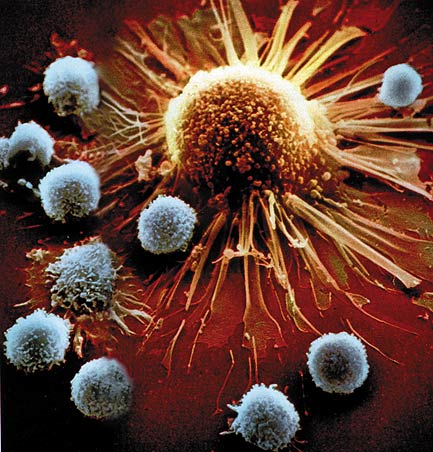 |
| A T cell (round shaped) surrounded by a cancer cell (with its cytoplasm scattered and fibre diffused). (left) | Killer-T cells (the small ones), which have surrounded a cancerous cell (the large one). |
How these cells identify the enemy is yet another unanswered question about the defence system. The receptors that should be present on their surfaces to enable them to identify of the target cells have not yet been discovered. Therefore, the mechanism they employ in identifying the enemy has not yet been clearly understood.
Despite all the technology at its disposal, mankind has still not been able to solve the details of the system these cells use to identify the enemy. Perhaps future technological advances will throw light on this system and this subject will no longer be a mystery. This, too, would be a piece of evidence proving the perfection of the current system, and what an intricate plan is involved in its creation.
Blood Cells
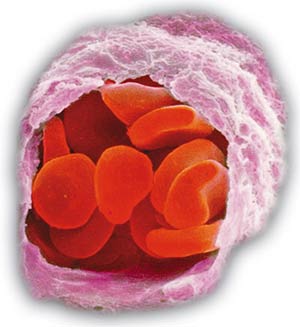 |
| Blood cells |
- Thrombocytes: The coagulation of blood is considered an ordinary event, which is largely ignored by people.
However, if the perfect system which makes this possible had not existed, human beings would experience significant risks and even bleed to death from the slightest injuries. The thrombocyte, which is one of the blood cells produced in the bone marrow, serves this function. It also includes a substance called serotonin that plays an important role in allergic reactions.
- Eosinophil: These blood cells have the ability to perform phagocytosis, i.e. destroy (phagocytose) any foreign cells entering the body.
- Basophil: A big, rough and single-nucleus blood cell which is found in small quantities in the blood, and abundantly in the dermal, splenic and intestinal connective tissues.
- Neutrophils: With an antibacterial quality, these blood cells protect the organism against foreign materials. In addition, they help the defence system with their phagocytosis capabilities.
Antigen Presenting Cells: "APC"
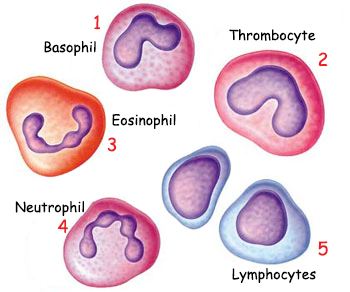 | |
| 1. Basophil | 4. Neutrophil |
| Above are the pictures of blood cells. | |
The duty of these cells is to present the antigen (enemy) to the T cells. Why a cell would serve such a function — an important responsibility — definitely needs further consideration. It knows that the T cells defend the human body, identify the enemy and present the enemy it captures to the T cells for them to provide intelligence about it.
Why would the cell do this? According to the theory of evolution, this cell should be concerned only about its own well-being. However, it serves the system, although it receives no benefit from it.
What is even more interesting is that the APC are very well aware of the requirements of the T cells. Based on this, the APC will break down the enemy cell and present to the T cell only the amino acid sequence. This means that the APC is even aware that the T cell will extract the required information from this sequence.
At this point, it would be useful to recall one thing: We mentioned actions such as "knowing", "calculating", "thinking", "serving". Unquestionably, those actions require a certain consciousness. It is virtually impossible for a being with no consciousness or will to perform these actions. Yet, here we are talking about these abilities as being inherent in these minuscule entities: common, tiny, unconscious cells. Therefore, who gives this consciousness, ability, and a glorious system to these cells?
The answer to this question is very evident. It is Allah Who creates the APC and the T cell, as well as all other cells in the body, in a harmonious way to serve in the same system.
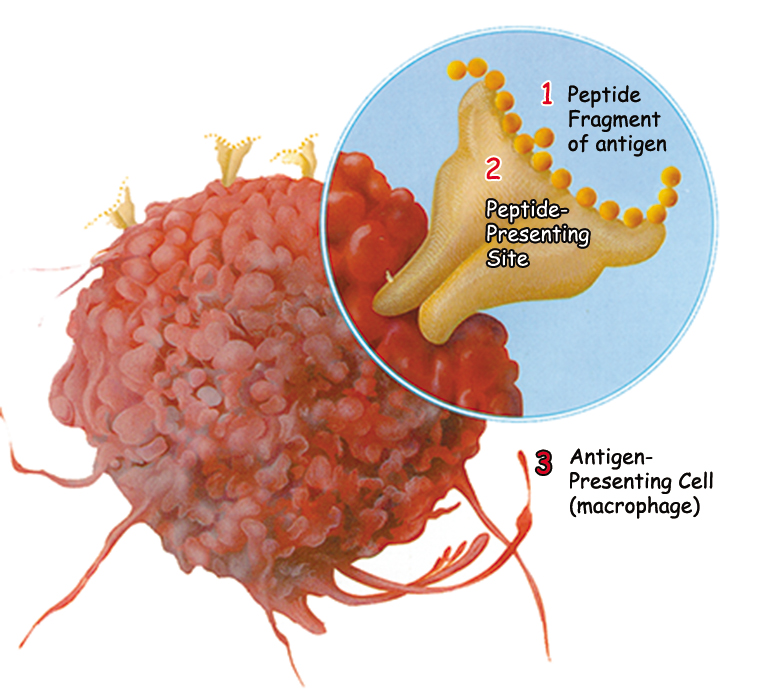 |
| 1. Peptide fragment of antigen |
| Examples of APCs are macrophages. They do this by taking the foreign material into a cavity in their cytoplasm - the part of the cell outside the nucleus - and adding digestive chemicals to them. These chemicals break the bacteria into fragments of the proteins from which they are made, fragments that are now harmless, but which can also be utilized. |
Footnotes
7. Ali Demirsoy, Kalıtım ve Evrim (Inheritance and Evolution), Ankara: Meteksan Yayınları p. 79
8. Michael J. Behe, Darwin’s Black Box, New York: Free Press, 1996, p. 30
9. Scientific American, September 1993, p. 58
10. Mahlon B. Hoagland, Roots Of Life, p. 106-107
